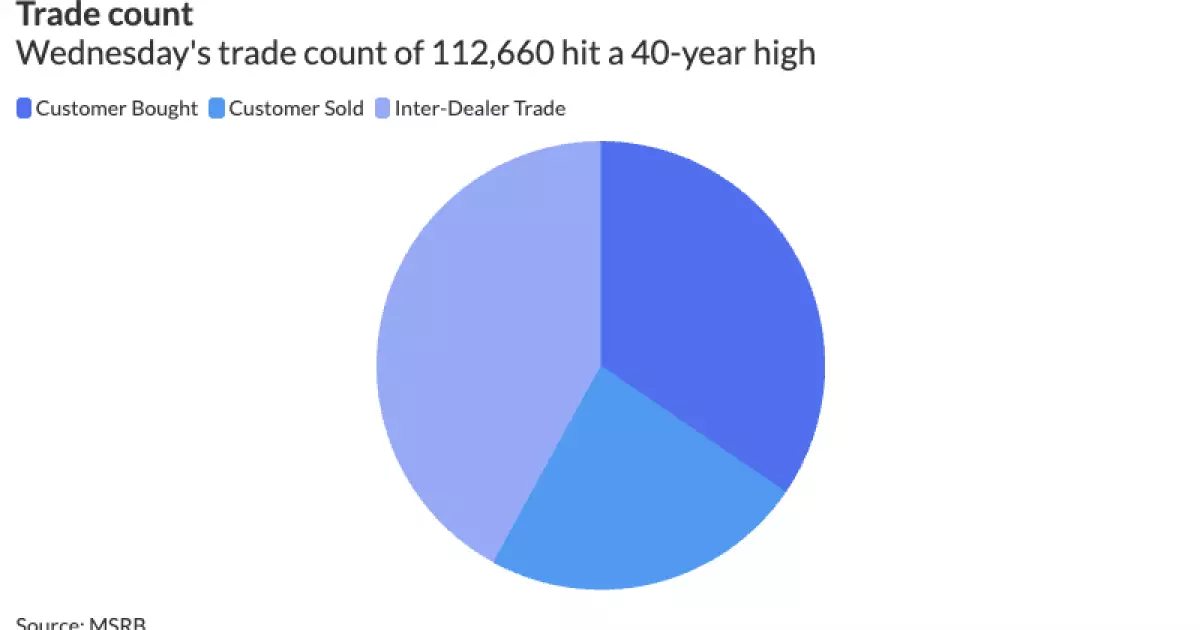The municipal bond market has never been one to shy away from volatility, but the tumultuous events that unfolded in March 2023 took many by surprise. Over the span of just a few days, municipal bond yields experienced some of the most significant fluctuations recorded in the last half-century. The acute market reactions were largely driven by President Donald Trump’s unexpected announcement of a 90-day pause on his retaliatory tariff plan, causing investor sentiment to dart from panic to cautious optimism. The trading floor became a battleground where yields plummeted to unprecedented lows, only to witness sporadic surges as the market attempted to recalibrate.
This spike in volatility is emblematic of larger structural issues within the municipal bond landscape that deserve scrutiny. As a center-right observer of economic markets, it is crucial to recognize that while government interventions can induce temporary relief, they often leave lasting repercussions on market stability and investor trust. One cannot ignore the unsettling question: are traders responding to genuine economic signals, or merely reacting to capricious political maneuvers?
September’s Muni Meltdown: A Cautionary Tale
The backdrop to this volatility was a sharp sell-off leading up to the announcement, culminating in a devastating single-day loss of 2.85%, marking one of the worst return figures in over three decades. What was particularly disturbing about September’s market activity was that liquidity vanished almost entirely. Traders were left scrambling, unable to buy or sell anything as fear gripped the market. The plummeting trust in municipal securities became painfully evident, as investors questioned the very liquidity of this supposedly stable asset class.
Investment professionals like Sean Carney of BlackRock articulated a pervasive sense of helplessness that many traders experienced. With investor confidence on a tightrope, the winds of panic had their feet firmly planted, exacerbating market instability. It’s a heartbreaking irony that the same government actions that aim to stabilize the economy can, in fact, inject chaos into carefully monitored markets.
The Manifold Impact of High Trading Volume
Despite the turmoil, one of the most extraordinary facets of this recent market activity was the sheer volume of trading – over 112,600 trades in one day, the highest since 1995. This statistic may appear reassuring, but upon closer examination, it signals a market struggling for direction. The enormity of trades coupled with significant fluctuations in bid-ask spreads highlights an elevated, yet uneasy appetite for risk.
For investors ensnared in this tempest, it poses daunting questions about the future of the municipal bond segment. When volumes spike amidst significant yield adjustments, the question looms larger: is the market ready to return to a semblance of normalcy, or will it remain entrenched in a pattern of erratic behaviors? This is further complicated by the ongoing challenges municipalities face in issuing bonds amid fluctuating interest rates and uncertain fiscal climates.
The Credit Quality Concerns
Looking deeper into the market structure, the role of credit quality in municipal securities cannot be overstated. As conditions turned sour and recessionary fears seeped into discussions, credit analysts and institutional investors had to urgently reevaluate their portfolios. A ripple effect was felt across different rating categories as bondholders started to withdraw from risk-ridden assets. Interestingly, despite the broader market downturn, AAA-rated bonds remained relatively insulated, making them the safe haven amid uncertainty.
However, a “flight to quality” mindset does not bode well for AA and BBB-rated issues that previously held appeal for yield-seeking investors. When market players pull back from secondary issues, these ratings could become susceptible to a steep sell-off. The inherent quality and credit structures matter significantly more than mere yield figures; investors would do well to remember that high returns are often accompanied by high risk.
Market Outlook: Navigating the Uncertain Waters
As munis are responding to engineered market changes initiated by political forces, the environment becomes increasingly complex. Assets once viewed as stable are now challenged, leaving investors fraught with uncertainty and suspicion. Moving forward, municipal bond traders will need to sharpen their focus and recalibrate expectations.
Investors eyeing the horizon should remain vigilant; the interplay between fiscal policy, credit science, and market dynamics will dominate headlines. Lady luck will certainly need to throw her support behind stabilizing forces if the municipal bonds are to reclaim their reputations as safe investments. The experiences of March 2023 offer lessons that should temper unbridled enthusiasm, reminding us that the municipal bond market, for all its charms, remains susceptible to the uncertainty inherent in political maneuvering.


Leave a Reply